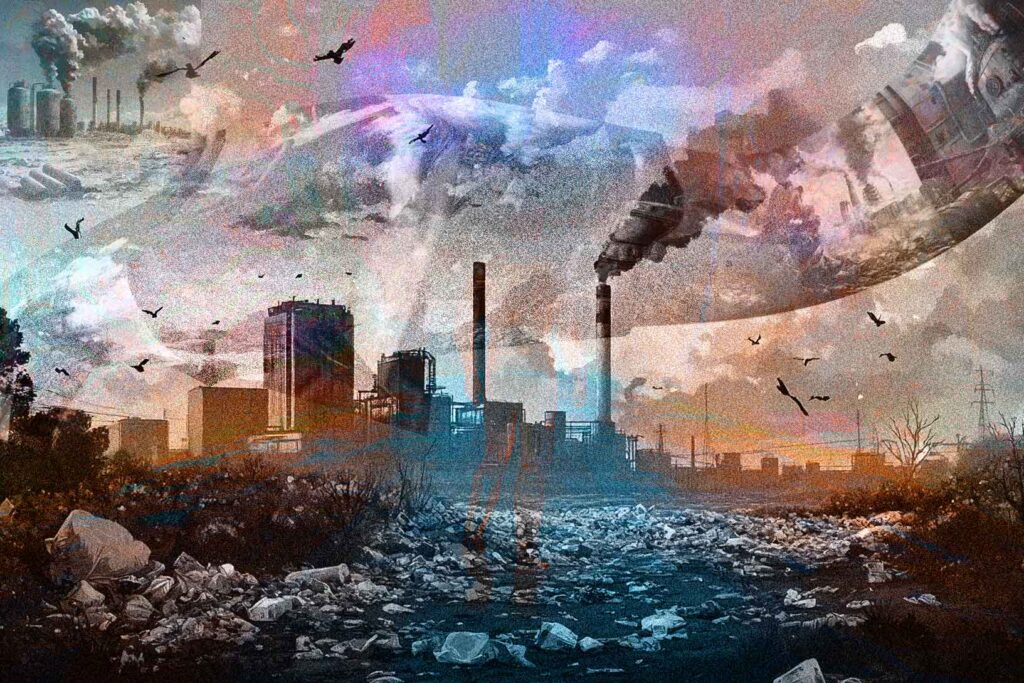Making Synthetic Fuel from Trash and Intermittent Renewable Energy
May. 03, 2025. 17 mins. read.
Interactions
RU Sirius republishes Keith Henson's technical draft on making synthetic fuel from trash as a complementary read to his insightful interview with Henson.
The following article is an engineering draft written by H. Keith Henson on March 28, 2025. I’m publishing it here, with his permission, as a complementary piece to my interview with him, published on Mindplex on May 3, 2025.
Abstract
This paper explores making synthetic fuel from trash and coal using renewable energy. The key reaction, dating back to the 1850s, involves heating carbon in steam to produce hydrogen and carbon monoxide. This endothermic reaction requires heating, traditionally done by alternately burning coke and injecting steam. Using intermittent renewable electricity for heating is now feasible.
A metric ton of carbon requires 3.03 MWh of heat to produce 13.1 MWh of syngas; a 4 to 1 energy gain. The gas can be stored, burned, or converted into methane, jet fuel, or diesel. The water-gas shift reaction can be used to increase the hydrogen at the expense of CO. The resultant CO2 (about half) can be sorted out of the gas stream and sequestered.
Following the water-gas shift, the Fischer-Tropsch (FT) process converts syngas into hydrocarbons, with water as a byproduct.
An example design uses 9,000 tons of trash daily from the Sylmar, CA landfill supplemented with coal, to produce syngas. The project would need significant power and infrastructure, including a 3-GW vaporizer and new high-voltage DC lines.
The venture could generate over $600 million annually from the sale of diesel, with costs for coal and power totaling $241 million. The project addresses landfill overuse and methane leakage, and provides a renewable energy solution for synthetic fuel production, though it requires substantial investment and the development of a 3-GW gasifier.
Background
History
In the early days of the Industrial Revolution, “gas works” made “town gas” by heating coke (burning it) then shutting off the air and blowing steam into the white-hot coke. This made CO and hydrogen. The proposal here is to heat any carbon source in steam with renewable power and then feed the syngas to a FT plant to make liquid fuels. It takes 3 MWh to vaporize a ton of carbon in steam (Making the steam takes 0.33 MWh/ton of carbon). This avoids burning the carbon to provide process heat.
‘Town gas’ is a more general term referring to manufactured gaseous fuels produced for sale to consumers and municipalities.
The original coal gas was produced by the coal gasification reaction:
The problem of nitrogen dilution was overcome by the blue water gas (BWG) process, developed in the 1850s by Sir William Siemens. The incandescent fuel bed would be alternately blasted with air followed by steam. The air reactions during the blow cycle are exothermic, heating up the bed, while the steam reactions during the make cycle, are endothermic and cool down the bed. The products from the air cycle contain non-calorific nitrogen and are exhausted out the stack while the products of the steam cycle are kept as blue water gas. This gas is composed almost entirely of CO and H2, and burns with a pale blue flame similar to natural gas.
Wikipedia
Chemistry
The chemical reaction upon which this depends is:
H2O + C → H2 + CO (ΔH = +131 kJ/mol)
The reaction is endothermic, so the fuel must be continually re-heated to maintain the reaction (Wikipedia). Traditionally this was done by alternately blowing air and steam through the hot coke, burning a lot of the coke to drive the reaction. The idea of heating the coke (or other carbon source) with electricity would not have made economic sense at that time, even if someone had thought of it.
Carbon is 12 g/mol, 83.3 mol/kg; a kg would soak up 10900 kJ. A ton of carbon evaporated in steam would need 10,900,000 kJ or 3.03 MW hours.
This would produce 1/6th of a ton of hydrogen with a combustion energy content of 39.4 MWh/ton, about 6.57 MWh. The CO combustion energy is 10.1 MJ/kg. A ton of carbon produces 2,333 kg of CO or about 6.55 MWh. The reaction makes about 13.1 MWh of syngas from a ton of carbon and 3 MWh of renewable electric power, an energy gain of over 4. Most of the energy in the gas is from carbon sources such as trash or coal.
It’s an efficient way to use intermittent power, though. From this point, the gas can be stored for winter, burned in combustion turbines, or made into methane, jet fuel, gasoline, or diesel.
Making Liquid Fuels
The FT is a collection of chemical reactions that converts a mixture of carbon monoxide and hydrogen, known as syngas, into liquid hydrocarbons. These reactions occur in the presence of metal catalysts, typically at temperatures of 150–300 °C (302–572 °F) and pressures of one to several tens of atmospheres. The FT process is an important reaction in both coal liquefaction and gas-to-liquids technology for producing liquid hydrocarbons.
Wikipedia
The FT reaction is:
CO + 2H2 → (CH2)n + H2O. Half the CO in raw syngas must be converted to hydrogen via the water-gas shift reaction.
CO + H2O → CO2 + H2. This CO2, about half, can be sorted out and stored.
Sasol has an FT plant in Qatar which makes 34,000 bbl/day of synthetic diesel. It has run since 2007.
Development
The only part of this proposal that does not already exist at scale is the electrically heated gasifier. There is no reason it would be very expensive per ton of capacity, certainly much less than platinum-containing electrolytic cells used to make hydrogen.
One problem with using trash as carbon source is that we don’t make enough of it. Can we collect enough biomass? Possibly. It would reduce the cost of waste collection if biomass were collected with the trash.
Producing Hydrogen
Optimized for hydrogen production, a ton of carbon can make 1/3rd of a ton of hydrogen at an energy cost of 3.3 MWh. A ton of hydrogen would take 10 MWh to make. At $20/MWh, the cost would be $200/ton or 20 cents per kg. To this must be added the capital cost of the plant and the disposal cost of the CO2, but even so, it should come in less than the $1.50/kg cost of gray hydrogen. Electrolytic hydrogen takes 50 MWh/ton to make, 5 times as much energy, and requires expensive platinum.
If the cost of a 9,000-ton per day plant is a billion dollars, written off in 5 years, the yearly production capital cost of hydrogen would be $1B/(3,000 t/d x 365 d/y x 5 y) or around $180/ton. That about doubles the cost of hydrogen to 40 cents per kg, which is still a bargain.
A Back-of-the-Envelope Example
The closest landfill to Sylmar, CA gets 9,000 tons of trash per day. Call it 4,000 tons/day of carbon. An installation half the size of Sasol’s Oryx plant (17,000 bbl/day) would need about 8,500 tons of carbon (half lost to making hydrogen), so it would need ~4,500 tons of coal per day in addition. That is around 45 rail cars per day which is a modest amount, and there is a nearby rail line. Tires could be fed into the vaporizer in place of coal.
Vaporizing this amount of carbon would take 8,500 t/24h x 3 MWh/t, a little over a GW. If the peak load (when renewable power is available) were 3 times the average, the vaporizer would use 3 GW. That just happens to be the capacity of the nearby Sylmar converter station, so existing power lines could handle it.
It is about 40 miles from the landfill to a Chevron refinery where the syngas could be processed into synthetic jet fuel and diesel. There are several old oil fields along the route. It would take effort to decide if the oil fields were suitable to store a buffer of syngas, but they probably are.
Rough Economic Analysis
Income at $100/bbl ($2.40/gal) for diesel, the gross annual sales of this venture would be 17,000 bbl/day x 365 days/year x $100/bbl or ~ $620 M/year.
Figuring cost, the trash is free, and the coal is $66 million (at $40/ton). The power would cost 3,000 MW x 365 days/year x 8 hours/day x $20/MWh or $175 million per year (The least expensive PV is $13.50 per MWh). This leaves $405 million gross income per year. Maintenance and labor might reduce this to $250 M. For a 5-year return on capital, the project could cost up to $1.25 B. The Sasol plant cost a billion dollars, but that included a refinery. Is there an unused pipeline close to the 405 freeway? If not, pipelines cost around $8 million a mile.
Research and Development
The one part of this project that does not exist at scale is a 3 GW vaporizer. That’s an awful lot of power but not unprecedented for industrial processes. A blast furnace for iron production ranges from 1 to 5 GW, most of it from the combustion of coke. Arc furnaces for mini steel mills are much smaller, typically 50 MW (they are melting, not reducing the iron). Arc is probably not the right approach to heat trash or coal. Induction heating might be better, though this is 60 times more power than any existing induction furnace. A complicating factor for induction heating is that the gasifier shell can’t be a conductor. How much hoop stress would be needed to contain the pressure needs to be calculated. It should not be much worse than water though that depends on the pressure.
Figuring trash at a density of one, and a holding time of a day, the interior volume of the gasifier would be 9,000 cubic meters. The largest blast furnace in the world is 6,000 cubic meters. If the vaporize were a 45-meter-tall cylinder, it would be a little over 16 m in diameter. This may be excessive, engineering studies are needed.
The trash and coal or tires need to be loaded through a gas lock. There are two variations used on blast furnaces, double bell and Rotating Chute.
One of these or some variation will be needed.
If there is excess steam available, the air in the trash could be purged by steam. Should the trash run through a grinder? Perhaps, how is the trash treated for incinerators?
One thing which should be added to a conveyer belt is an X-ray and an AI to read the pictures in real time for human bodies. Tracking of the trucks dumping on the belt would also be useful in the event bodies are found. There needs to be provision to stop the belt and recover a body. As a guess this would happen once a year.
The X-ray could measure the amount of carbon in the trash and a control computer would determine the amount of coal needed to use the entire electric heat input.
The belt system will need to be enclosed to prevent wind from blowing trash off the belt. It should incorporate cleaning provisions. Depending on the control algorithms the same belt could be used to add the coal. Coal volume should be around ¼ of the trash.
Gas Flow
The flow of syngas would be 1/6 ton of H2 per ton of carbon. Hydrogen is 500 mol/kg, 500 k mol/ton; 1/6 ton would be 83.3 k mol. At STP, a mol of a gas fills 22.4 l, 1/6 ton would have a volume of 1867 kl. The CO volume is equal, so 3,733 cubic meters of gas flow per hour per ton of carbon vaporized. For a peak of 1,000 tons per hour, the gas flow would be 3,733,000 cubic meters per hour. The proposed vaporizer is 200 square meters in area making the upward gas flow around 3,733,000 m3/200 m2 per hour or ~5 m/s (11 mph). That does not include the pyrolysis gas or the water vapor from drying out the trash. This is probably not too fast to lift the trash, but further research is needed.
Vaporizing 8,500 tons of carbon per day would need about 12,800 tons of steam or 531 tons per hour or 147 kg of steam per second. Assuming water at 100 degrees C, and 2,257 kJ/kg to boil, it would take 331,779 kJ/sec to boil the water or 332 MW, or about ten percent of the power input to vaporize the carbon in steam. The steam could be generated in counter current pipes lining the induction gasifier and blown through or across the pool of slag to react with the carbon. The shape of the induction gasifier might be like the upper part of a blast furnace, opening up to channel the syngas along the steam generator pipes (The newly made syngas has to be cooled, and it is hotter than 100 C). Steam use will be three times higher in peak production periods.
Steam generation tube area can be calculated from the days of locomotives. The ASME determines boiler horsepower as:
The amount of energy needed to produce 34.5 pounds (15.65 kg) of steam, per hour, at a pressure and temperature of 0 Psig (0 bar) and 212oF (100oC), with feed water at 0 Psig and 212oF. One boiler horsepower is about 33,479 Btu per hour (about 9,810 watts, 8430 Kcal/Hr).
531,000 /15.65 is 34,000 boiler HP. The Area would be 577,000 square feet or 53600 square meters (An AI using somewhat higher heat transfer got 19,600 square meters). The inside of the vaporizer is 56.5 square meters per meter of height. 30 meters would be short of the needed area by a factor of 31. This indicates that the water boiler part of the vaporizer will need many steam pipes around the edges to give enough heat transfer surface. Keeping the pipes from absorbing the induction heat will be a problem. They may have to be ceramic.
Gas Cleanup
The bottom of the induction gasifier will have a pool of slag (mostly metal and glass) that must be drained off from time to time. Aluminum and iron in the trash will react with steam to make hydrogen. The gas flow would be up through 40 meters of trash. This should remove most of the pyrolysis products (smoke, bio-oil) and recycle the carbon down where it can be reacted with steam. The remainder will be cleaned up with an electrically heated catalytic grid or alternately a plasma torch. The steam content of the gas stream must be controlled to assure enough steam to react with the carbon. Read more here.
The design of this subsystem will need careful consideration and probably counter current flow to get the gas hot enough to react without requiring excessive power.
One safety issue is apparent. If the syngas is going to be used to make liquid fuels, about 1/3 would be CO. A leak of the magnitude of the Aliso Canyon leak could kill a large number of people from the CO. Read more here.
This will have to be addressed. Leaking syngas could be burned to make it safe.
Another consideration is that considerable energy is released in the FT reaction and the reaction runs away at higher temperature. The possibility of this happening in a storage reservoir needs to be addressed. It would be quite embarrassing to have an oil field explode.
Funding a Study
Modern warfare is completely dependent on jet fuel and diesel. However, we live at the tail end of the fossil fuels era. While supplies are currently adequate, this will not be true in the long term. The US DoD had an experimental project that made 11 gallons of diesel from a ton of trash. This method, using renewable energy for heat, would make about 80 gallons per ton of trash supplemented with coal.
The proposal which might be presented to DARPA is to use trash and coal heated by renewable power in steam to make syngas. The syngas can be turned into jet fuel and diesel by FT plants.
There are lots of engineering and economic problems to solve, but the point is that intermittent renewable energy can be used to make synthetic fuel to replace that made from oil.
The induction-heated vaporizer is as big as the largest blast furnace.
It would take 8-10 of these to make all the Los Angeles trash into diesel. At 5 square km/GW for PV, 15 km2 for one of them, 150 km2 for enough power to make diesel out of all the Los Angeles trash. The existing Pacific Intertie is 3 GW, so to get the power into the vaporizers would take ~10 new high-voltage DC lines.
It’s a huge job, but possible with existing technology.
Another possible source of funding at least for studies is the airlines.

Environmental Considerations
A problem this solves is that the US has been overrun by landfills. The EU and China use incinerators that could be replaced by this method to make syngas.
This proposal would stop landfill leakage of methane. Landfill leakage is a substantial source of methane.
The process would eliminate persistent chemicals and drugs if sewer digester sludge were included in the feed.
This process eliminates plastics of all kinds. Unlike incinerators, it releases no dioxins into the environment from PVC.
Harvested brush could be used in place of coal.
Energy Considerations
A problem with renewables is that the grid cannot absorb them when the load is smaller than the supply, leading to curtailment.
This is wasteful, but using this energy to make hydrogen is too expensive. The electrolyzers are expensive largely due to the platinum in them and using them less than all the time increases the effective capital cost (Any capital eqipment used ¼ of the time increases the capital cost by a factor of 4).
This proposal would purposely install much more renewable power than the grid could absorb and use all the power in excess of the grid needed to make fuel.
Objections
- Trash is “not a resource”.
It is a source of carbon, though. If you have lots of excess renewable power and a low cost source of carbon, you can make diesel for around $100/bbl. The big problem is that we don’t make enough trash.
Converting syngas to jet fuel or diesel is around 75 percent efficient. It is well understood. The Sasol plant in Qatar has been operating since 2007 and a previous version that ran on coal was supplying much of the fuel for South Africa during the apartheid era.
- What are the specific challenges in scaling up this process to a commercially viable level, especially in terms of integrating intermittent renewable energy?
The one piece that does not exist at scale is the electrically heated vaporizer.
- What is the most efficient way to store and transport the syngas produced by this reaction?
The only economical way I am aware of for storage is an empty gas or oil field. Transport is by pipeline.
- How do you plan to address the long-term sustainability of this process, especially in terms of CO2 emissions and air capture?
If you are making hydrogen from coal this way, you can capture and store all the CO2. In making fuel, half the carbon is in the fuel and is released when the fuel is used. If half the carbon comes from biomass or trash, the accounting is more complicated. The fuel might be rated as carbon neutral. Eventually, all the carbon will have to come from biomass or be taken out of the air if humans are still using hydrocarbon fuels. None of these will be problems after nanotechnology comes along, but who knows how long that will take?
- What are the potential costs and environmental trade-offs compared to other forms of renewable energy storage or synthetic fuel production?
There isn’t any storage out there for renewable energy that scales to seasons. Such synthetic fuel production that exists is many times as expensive as oil.
All the trash that Los Angeles produces plus about half that much in coal would supply the US military with fuel.
Let us know your thoughts! Sign up for a Mindplex account now, join our Telegram, or follow us on Twitter.


.png)

.png)


.png)





0 Comments
0 thoughts on “Making Synthetic Fuel from Trash and Intermittent Renewable Energy”